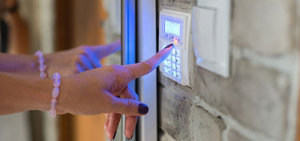 Introduction:
Introduction:
For centuries, homeowners and business owners have sought ways to protect their valuables and deter unwanted visitors. From intricate locks to loyal guard dogs, various methods have been employed to safeguard property. However, in the modern era, burglar alarms have emerged as a sophisticated and effective solution for security.
The evolution of electricity in the 19th century revolutionized alarm systems. In 1853, Augustus Fitch patented the first electric burglar alarm, utilizing a closed circuit to trigger a bell upon entry. Since then, advancements in technology have led to an array of burglar alarm types, each offering unique features and functionalities.

A Multifaceted Defense: The Uses of Burglar Alarms
Burglar alarms serve various purposes beyond simply deterring intruders. They can:
- Alert occupants: A loud siren or flashing lights instantly notify residents of a potential break-in, allowing them to take necessary precautions.
- Scare away intruders: The sudden activation of an alarm can often startle and disorient burglars, prompting them to flee the scene.
- Summon help: Many alarms connect to monitoring centers or automatically dial emergency services, ensuring a swift response.
- Monitor activity: Some advanced systems track door and window openings, temperature changes, and even motion within the property, providing valuable insights into potential security breaches.
- Document evidence: Some systems capture video footage or record audio upon activation, potentially providing crucial evidence for law enforcement.
Types of Burglar Alarms
With advancements in technology, burglar alarms come in a variety of types, catering to diverse needs and budgets. Here’s a brief overview of some common types:
- Wired alarms: These traditional systems rely on a network of wires connected to sensors and control panels. They offer high reliability but can be more expensive and complex to install.
- Wireless alarms: These systems utilize radio signals to communicate between sensors and the control panel, making them easier to install and customize. However, they may be susceptible to interference and require battery changes.
- Monitored alarms: These systems connect to a central monitoring station, ensuring a swift response from security personnel or emergency services in case of an alarm activation.
- DIY alarms: These affordable options often lack professional monitoring but offer basic features like loud sirens and motion detection.

Burglar Alarms: A Shield Against Unwanted Intrusions
For centuries, homeowners and business owners have sought ways to protect their valuables and deter unwanted visitors. From intricate locks to loyal guard dogs, various methods have been employed to safeguard property. However, in the modern era, burglar alarms have emerged as a sophisticated and effective solution for security.
A Historical Journey: From Bells to Buzzers
The concept of an alarm system dates back to ancient times. In 2nd-century BC China, water clocks were used to trigger gongs and bells, alerting residents to potential intruders. In the Middle Ages, complex systems of bells and tripwires were employed to guard castles and monasteries.
The evolution of electricity in the 19th century revolutionized alarm systems. In 1853, Augustus Fitch patented the first electric burglar alarm, utilizing a closed circuit to trigger a bell upon entry. Since then, advancements in technology have led to an array of burglar alarm types, each offering unique features and functionalities.
A Multifaceted Defense: The Uses of Burglar Alarms
Burglar alarms serve various purposes beyond simply deterring intruders. They can:
- Alert occupants: A loud siren or flashing lights instantly notify residents of a potential break-in, allowing them to take necessary precautions.
- Scare away intruders: The sudden activation of an alarm can often startle and disorient burglars, prompting them to flee the scene.
- Summon help: Many alarms connect to monitoring centers or automatically dial emergency services, ensuring a swift response.
- Monitor activity: Some advanced systems track door and window openings, temperature changes, and even motion within the property, providing valuable insights into potential security breaches.
- Document evidence: Some systems capture video footage or record audio upon activation, potentially providing crucial evidence for law enforcement.
- A Spectrum of Options: Types of Burglar Alarms
- With advancements in technology, burglar alarms come in a variety of types, catering to diverse needs and budgets. Here’s a brief overview of some common types:
- Wired alarms: These traditional systems rely on a network of wires connected to sensors and control panels. They offer high reliability but can be more expensive and complex to install.
- Wireless alarms: These systems utilize radio signals to communicate between sensors and the control panel, making them easier to install and customize. However, they may be susceptible to interference and require battery changes.
- Monitored alarms: These systems connect to a central monitoring station, ensuring a swift response from security personnel or emergency services in case of an alarm activation.
- DIY alarms: These affordable options often lack professional monitoring but offer basic features like loud sirens and motion detection.
- Choosing the right type of burglar alarm depends on several factors, including budget, property size, security needs, and desired level of monitoring. Consulting with a security professional can help determine the optimal solution for your specific requirements.

Five Burning Questions Answered: Burglar Alarm FAQs
Navigating the world of burglar alarms can be confusing. Here are answers to five frequently asked questions:
1. Are burglar alarms effective deterrents?
Studies have shown that burglar alarms significantly reduce the risk of break-ins. The loud sirens and potential for immediate response often dissuade intruders from targeting properties with alarms.
2. What happens when a burglar alarm is triggered?
The response depends on the type of alarm system. Monitored alarms will automatically notify the monitoring center, who will dispatch security personnel or contact emergency services. Unmonitored alarms will typically only sound a loud siren or activate flashing lights.
3. How much do burglar alarms cost?
The cost can vary greatly depending on the type, features, and monitoring service. Basic DIY systems can start around $50, while professional monitored systems can reach several hundred dollars.

Conclusion:
In the consistently developing scene of safety, robber cautions stay a foundation of home and business security. From their unassuming starting points as banging chimes to the present complex organizations of sensors and checking frameworks, these mechanical watchmen have ceaselessly adjusted to address the difficulties presented by wrongdoing.
Their adequacy lies not just in deflecting gatecrashers but rather in offering genuine serenity. The information that a careful framework stands watch, prepared to sound the caution and bring help, gives a priceless feeling of safety. Past hindering break-ins, thief alerts can archive proof, record movement, and proposition important bits of knowledge into potential security breaks.
In any case, the obligation of keeping a protected climate doesn’t exclusively lay on innovation. Understanding how to utilize and keep a caution situation, picking the right kind for your necessities, and rehearsing legitimate systems are essential elements in expanding its viability.
At last, robber alerts are not simply contraptions; they are an interest in true serenity. In this present reality where security dangers can arise whenever, they offer a strong safeguard, safeguarding resources as well as the feeling of safety and prosperity that is so fundamental in our lives. As innovation keeps on propelling, we can expect considerably more complex and savvy alert frameworks to arise, further fortifying our safeguards against undesirable interruptions.
.









